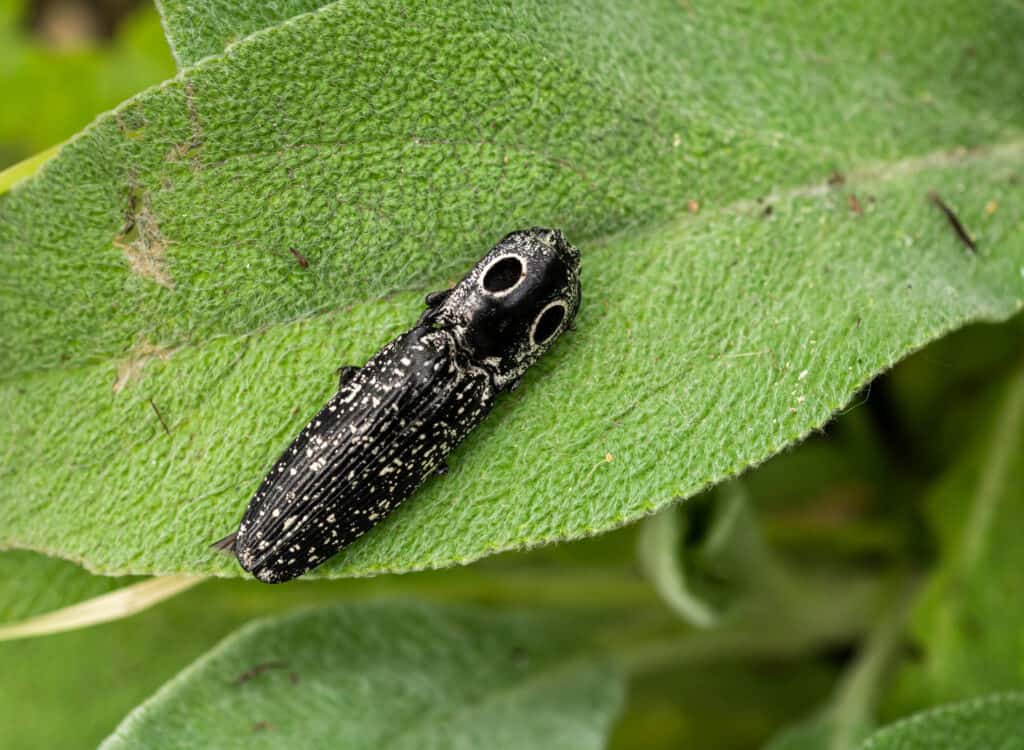Click Beetle
Click beetles are named for the clicking noise they make to escape predators.
Advertisement
Click Beetle Scientific Classification
Read our Complete Guide to Classification of Animals.
Click Beetle Conservation Status
Click Beetle Locations

Click Beetle Facts
- Name Of Young
- wireworms
- Group Behavior
- Solitary
- Fun Fact
- Click beetles are named for the clicking noise they make to escape predators.
- Biggest Threat
- Spiders
- Most Distinctive Feature
- Clicking mechanisms on their thorax
- Other Name(s)
- Typical click beetles, snapping beetles, spring beetles, skipjacks
- Habitat
- On the ground, on plants, in decaying wood, or hiding under bark
- Diet
- Herbivore
- Lifestyle
- Nocturnal
- Favorite Food
- Potato, strawberry, corn, and wheat
- Type
- Beetle (Insect)
- Common Name
- Click beetle
- Special Features
- They can producing a violent "click" to startle predators
- Number Of Species
- 9300
- Location
- Worldwide
View all of the Click Beetle images!
Click beetles are named for the clicking noise they make to escape predators.
Summary
Click beetles are insects in the family Elateridae. They’re characterized by their ability to snap a spine-like structure into a groove on their thorax. This makes a clicking sound that startles predators and helps them to get back up when they fall on their backs. The larvae of click beetles are known as wireworms. These long slender larvae are destructive pests that attack seeds, roots, and underground stems of various plants.
Click Beetles Species, Types, and Scientific Name
The name click beetles apply to insects in the family Elateridae. They also have other common names, such as snapping beetles, spring beetles, elaters, and skipjacks. The insects in this family are characterized by their unusual click mechanism, which they use to avoid predation.
Although there are a few other families of insects with similar mechanisms, members of the family Elateridae are considered the “true click beetles.” Examples of false click beetles include members of the family Eucnemidae and Cerophytidae. These are known as false click beetles and rare click beetles, respectively.
This cosmopolitan beetle family has up to 9300 known species found worldwide. Close to 1000 of these species are native to North America. The eyed click beetle (Alaus oculatus) is one of the most popular members of this family. Another popular group is the Pyrophorus (also known as fire beetles). They’re more popular for their impressive bioluminescent property.
Appearance: How to Identify Click Beetles

The eyed click beetle (Alaus oculatus) is characterized by prominent oval eye spots on the pronotum.
©Lee Ellsworth/Shutterstock.com
Snapping beetles vary in size and appearance. While some species in this family are large and colorful, others are dull-colored and are less than 2cm (0.78inches) long. Most click beetles have an elongated shape with parallel sides and a flattened body. They usually have backward projections on the side corners of their exoskeleton extending behind their head.
Smaller species are typically around about 0.6cm (1/4 inches) long. However, larger ones like the Alaus oculatus can be up to 1 to 1.5 inches (2.5cm to 3.8cm) in length. Most species are brown or black. However, there are a few with bright colors. These are typically reddish and yellowish with patterns on their shell.
The eyed click beetle (Alaus oculatus) is characterized by prominent oval eye spots on the pronotum. One unique characteristic of this group of insects is their ability to snap their prothorax and mesothorax segments to flip the air. They use this acrobatic move to right themselves, and it also produces a violent click sound that startles predators.
The larvae of these beetles are called wireworms. These brownish, hard-bodied worms have a brownish color. They’re cylindrical and often measure between ½ to 2-½ inches (1.2cm 6.4cm) in length. Wireworms have 3 pairs of tiny true legs behind their heads, and their body ends with a flat, shield-like segment.
Adult snapping beetles are typically nocturnal. They’re leaf feeders, but they’re hardly ever problematic pests. They may enter homes sometimes, but they’re not household pests. Wireworms mostly feed on dead organic matter. However, some species are serious agricultural pests. In addition, the larvae of a few species are active insectivorous predators.
Habitat: Where to find Click Beetles
Click beetles are found worldwide in various habitats. They’re mostly outdoor insects living in fields, gardens, and bushes but rarely indoors. Adults spend most days hidden under barks or near plants. However, they’re more active at night and often fly toward light sources. Sometimes, in the mornings, you may see them resting on the side of buildings near a light source. The larvae hatch from eggs underground and can remain in the soil for up to 3 years.
Diet: What Do Click Beetles Eat?
Adult click beetles are herbivorous. They feed on the leaves of various plants. They’re also attracted to sweet liquids such as nectar and other plant juices. The larvae (wireworms) eat different foods depending on the species. Most species feed on decaying plant matter in the soil, such as rotting wood. However, many species are agricultural pests, feeding on plant roots, sprouts, and seeds. Common crops they feed on include potato, strawberry, corn, and wheat. Some wireworms are also insectivorous. They prey on the larvae of other beetles, such as those of long-horned beetles and other insects that live in rotting wood.
What Eats Click Beetles?
Rodents such as moles and shrews can prey on click beetles. Insectivorous birds can also pick them up and feed on them. Other insects, spiders, and mantises also prey on this beetle. Their clicking sound and acrobatic jump are adaptations that help them escape from predators. But this doesn’t always work, especially with larger predators.
Prevention: How to Get Rid of Click Beetles
Adult snapping beetles hardly eat at all. Species that feed only eat very little, so farmers do not consider them serious agricultural pests. Unfortunately, we cannot say the same for their larvae. They attack various crops and tend to be very resistant to insecticides. They can also pass through the soil, spreading from one plant to the other within a short time.
Methods of controlling wireworm infestations include clean cultivation and clean fallowing. You can also consider planting seed shallow and under warm conditions. This allows the seeds to germinate faster than the wireworm can damage it. There may be specific management practices for specific crops susceptible to these worms’ damage.
Related Animals
View all 235 animals that start with CClick Beetle FAQs (Frequently Asked Questions)
Why is it called a click beetle?
Click beetles are named for the clicking noise they make to escape from predators. The beetle can snap a spine-like structure on their thorax into a groove beneath its pronotum. The clicking motion helps the beetle flip itself the right way and startles predators to allow them to escape an attack.
Are click beetles dangerous?
No. Click beetles are not dangerous to people. Adults can cause minor crop damage, but they’re not considered serious agricultural pests. Their larvae are more of a threat to crops than adult forms.
Why am I getting click beetles in my house?
Click beetles rarely invade homes. However, if you find one in your home, they probably entered by accident or to escape from cold weather. You can pick the insect up by hand or use a vacuum to remove it. To keep the insect out, you should seal cracks, holes, and other potential entry points.
Why does a click beetle jump?
Click beetles often jump as a defensive response. Their acrobatic jump and the clicking sound startle predators and allow them to escape. They also jump to right themselves if they fall on their dorsal side.
Thank you for reading! Have some feedback for us? Contact the AZ Animals editorial team.
Sources
- Wikipedia, Available here: https://en.wikipedia.org/wiki/Click_beetle
- Encyclopaedia Britannica , Available here: https://www.britannica.com/animal/click-beetle
- Texas A&M Extension, Available here: https://extensionentomology.tamu.edu/insects/click-beetle/
- Missouri Department of Conservation, Available here: https://mdc.mo.gov/discover-nature/field-guide/click-beetles
















